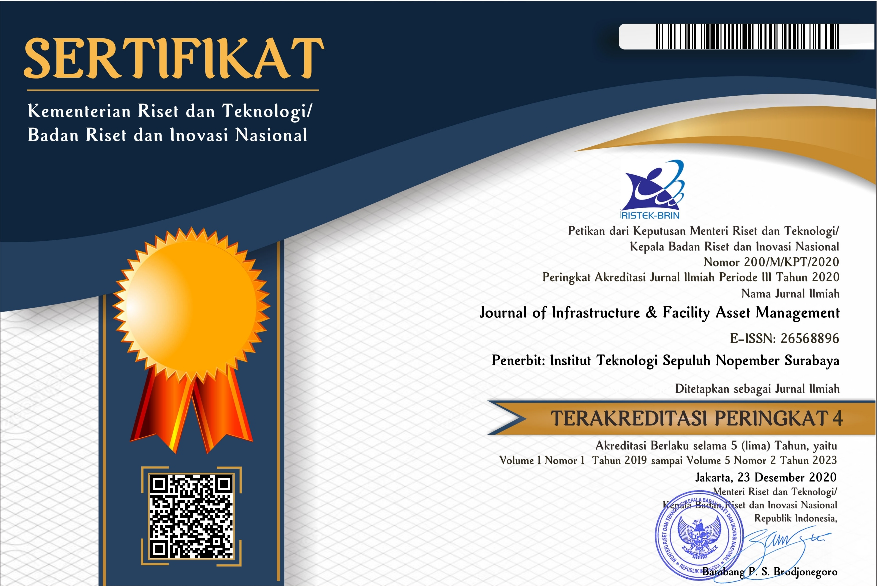Effect of Embankment Construction Pace on Slope Stability Wih Varied Heights on Organic Soft Soil in the Sicincin-Padang Toll Road Sta 10+250-10+400
Abstract
On the Sicincin-Padang toll road section there are several geotechnical problems, one of which is that at the Sta 10+250-10+400 is dominated by an organic soil. In the implementation of a 4.0 meter high embankment there are cracks appeared on the left side of embankment toe. Based on the evaluation results of monitoring geotechnical instruments in the field, the cracks that occur can be caused by the bearing capacity failure or due to the implementation stages of embankment construction is too fast. The method used in this research is to use finite element method by numerical simulation using Plaxis 2D program to determine the stability of embankment slope stability acording to the stages of implementation in the field and by modeling a staged construction, where the speed of embankment construction depends on the thickness of the embankment layer used, which is 15 cm to 25 cm until the design height is reached and the consolidation time is 1 day to 14 days for each additional 1 meter of embankment height. The porpose of this study is to determine the stages of implementation that are safe and compliant with the design criteria requrements.
From the modeling results the existing embankment construction in the field has a safety factor value of SF=1.156. In this research, variations in the construction stages that have been modeled were obtained that are safe and meet the design criteria at the location under review are; at Sta 10+250 with using 25 cm thickness fill layer and 14 days consolidation time, Sta 10+350 with a 15 cm thickness fill layer and 7 days consolidation time, Sta 10+400 with a 25 cm thickness fill layer and 5 days consolidation time. There are differences in the effective time at each of the locations reviewed, this is due to differences in geometric embankment conditions at each location. From the results of modeling analysis, it also found that by reducing the thickness of the embankment fill layer and increasing the consolidation time, the value of the safety number will increase, the amount of settlement will increase, the amount of lateral movement will decrease and the excess pore water pressure will decrease.
Full Text:
PDFReferences
ASTM Annual Book (1992). “Standard Classification of Peat Samples by Laboratory Testing (D4427-92)”. ASTM, Section 4, Volume 04.08 Soil and Rock. Philadelphia.
SNI 8460:2017 Persyaratan Perancangan Geoteknik, Pub. L. No. 8460:2017 (2017). www.bsn.go.id
Suprayitno, H., & Soemitro, R., A., A. (2018). “Pemikiran Awal tentang Konsep Dasar Manajemen Aset Fasilitas”. In Jurnal Manajemen Aset Infrastruktur & Fasilitas (Vol. 2, Issue 1).
Manudianto, D., Endah, N., & Siahaan, P., H. (2023). “Alternative of Soil Improvement Methods on Organic Soil Using Preloading and Vertical Piles for Embankment with Varied Heights. Case Study: Contruction of Batanjung Port Acces Road in Pulau Pisau Regency, Central Kalimantan”. Journal of Infrastructre and Facility Asset Management, (Vol. 5, Issue 1).
Badarinath, R., & El Naggar, H. (2021). “Effects of construction sequence and pace on the stability high embankments founded on soft marine clay”. Transportation Geotechnics. https://doi.org/10.1016/j.trgeo.2021.100635
Susila, E. & Apoji, D. (2012). “Settlement of a Full Scale Trial Embankment on Peat in Kalimantan: Field Measurements and Finite Element Simulation”. Jurnal Teoritis dan Terapan Bidang Rekayasa Sipil, (Vol. 19, No. 3)
DOI: http://dx.doi.org/10.12962%2Fjifam.v6i0.19953
Refbacks
- There are currently no refbacks.
Visitor :
Flag Counter

Journal Of Infrastructure & Facility Asset Management by Institut Teknologi Sepuluh Nopember is licensed under a Creative Commons Attribution-ShareAlike 4.0 International License.





